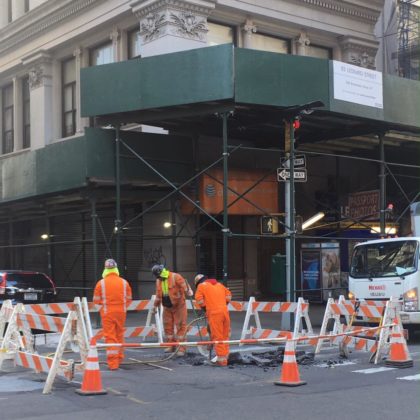Why Does So Much Street Construction Happen on Weekends?
 At the end of January, K. emailed about street construction happening on Vestry, between Hudson and Varick: Was there a schedule for it, and was there someone from the city overseeing it to contact about issues about it? K. found out soon enough that it was Con Edison. As for the other questions, I thought I must know who oversees street construction, and then I realized I didn’t, so I asked Community Board 1. They said no one does; you just have to complain via 311. Judging from the number of complaints I get about after-hours street construction, I still think the city should create a dedicated office for it. People should be able to learn the scope and expected duration of any project.
At the end of January, K. emailed about street construction happening on Vestry, between Hudson and Varick: Was there a schedule for it, and was there someone from the city overseeing it to contact about issues about it? K. found out soon enough that it was Con Edison. As for the other questions, I thought I must know who oversees street construction, and then I realized I didn’t, so I asked Community Board 1. They said no one does; you just have to complain via 311. Judging from the number of complaints I get about after-hours street construction, I still think the city should create a dedicated office for it. People should be able to learn the scope and expected duration of any project.
A week or two later, Con Edison construction started happening right outside my apartment. The jack-hammering was extremely loud, and it went on for weeks—but only on weekends. (The steam system appears to be in a state of turmoil across southeast Tribeca, if they many vents are any indication.) That got me wondering: How does the Department of Transportation determine the timing for specific projects? Why are some on weekdays, some on weekends, some late at night? I hounded the DOT press department for several weeks before I got to speak with Luis Sanchez, the Manhattan Borough Commissioner. Normally, I let a topic go if it doesn’t seem to be headed anywhere, but I knew there has to be some protocol for street construction timing. Here’s what he said:
I’ll speak in general terms of how it gets evaluated. First, there’s where the location of actual work is going to be. For example, if it’s along the curb lane—the parking lane, if you will—versus in the middle of the street, we would be more likely to grant them weekday permits. If the work is in the middle of the street, it has to be evaluated in terms of whether it’s a major northbound or southbound street or a minor street. So a lot will depend on the location of the excavation of the work. And the duration of the project: A project that might take one or two days could be done during the weekday, versus a longer project, when we night give them weekend work.
Then, are there bus routes? Will they be impacted? The number of lanes of traffic. Are there other construction projects in the immediate vicinity? We don’t want two to three construction projects on top of each other. (For instance, one in the left lane and one in right lane.) All are evaluated on a site-by-site basis.
If some of the work has to be done at night, our stipulations call for all noisy work to stop at 10 p.m. The contractor can continue, but it has to be non-noisy work. For instance, if he gets there at 7 p.m., he’s allowed to do excavation work till 10 p.m. After 10 p.m., the work might change to pulling conduits, inspecting manholes, working inside the manholes…. Unfortunately, these contractors sometimes figure they can get away with working past 10 p.m. We won’t know about it till the next day, when we get 311 complaints. So if they’re at the site for an extended period of time, we’ll send an inspector to monitor the location the following night. If they’re doing work, they get a summons or they’ll be forced to stop.
It made sense to me that the DOT would be most concerned with the flow of traffic, especially on weekdays, when there’s more of it. But, as I explained to Sanchez, there’s the nagging feeling around here that the DOT has decided that certain areas are commercial—and more or less uninhabited on weekends—when they have actually become almost entirely residential. Does the composition of a block affect the decision-making?
It is a factor. Part of what has happened, the places where night work is allowed have become more residential. [“Like everywhere in Tribeca!” I interrupted.] We try to balance the needs of everybody. We don’t want to have a contractor create gridlock during the day. Obviously, on weekends, there’s not as much traffic, so a lot of utility work happens on weekends, but of course people expect to have a quiet weekend at home.
The question, it occurred to me too late, is to what degree the commercial-vs.-residential factor plays in the decision, and what sort of resources does the DOT use to determine the makeup of a block? Do they have a database from 1983? My guess is that they look around and decide. In any event, judging from the emphasis Sanchez put on traffic flow (and not impeding it), my guess is that it’s a relatively small factor in the process.
The other main takeaway: If you do hear noisy work after 10 p.m., you must call 311 if you want any hope of it stopping the next night.














Areas are judged commercial or residential based upon how they are characterized in the Zoning Resolution.
Also, emergency work, e.g. broken water pipe, gets approved with a higher priority, but some traffic flow must still be maintained.